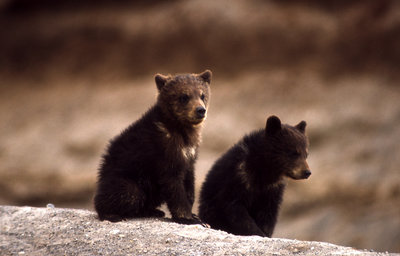Black Bear
The American Black Bear (Ursus americanus), also known as simply the black bear or cinnamon bear, is the most common bear in North America. more...
The black bear occurs throughout much of North America from northern Canada and Alaska south into Mexico, from the Atlantic to the Pacific. This includes 39 of the 50 U.S. states and all Canadian provinces. Populations in east-central and the southern United States remain in the protected mountains and woodlands of parks and preserves, though bears will occasionally wander outside the parks' boundaries and have set up new territories in recent years in this manner. While there were probably once as many as two million black bears in North America, the population declined to a low of 200,000 before rebounding in recent decades, partly due to conservation measures. By current estimates, more than 600,000 are living today.
Appearance
The black bear is about 1.5 metres (5 feet) long. Females weigh between 40 and 180 kg (90 and 400 pounds), while males weigh between 50 and 400 kg (110 and 880 pounds). Cubs usually weigh between 200 and 450 g (between 7 oz and 1 pound) at birth. The adult black bear has small eyes, rounded ears, a long snout, a large body, and a short tail. They have an excellent sense of smell. Though these bears indeed generally have shaggy black hair, the coat can vary in color depending on the subspecies: from white through chocolate brown, cinnamon brown, and blonde, found mostly West of the Mississippi River, to black in the East (the same is generally true in Canada with the border being between Manitoba and Ontario). Further adding to the confusion, black bears occasionally sport a slight white chest blaze on either side of the river.
While black bears are able to stand and walk on their hind legs, they usually stand or walk on all four legs. (When they do stand it usually is to get a better look at something.) The black bear's characteristic shuffle results from walking flat-footed, with the hind legs slightly longer than the front legs. Each paw has five strong claws used for tearing, digging, and climbing. One blow from a powerful front paw is enough to kill an adult deer.
Habitat and behavior
Black bears prefer forested and shrubby areas but use wet meadows, high tidelands, ridgetops, burned areas, riparian areas, and avalanche chutes. They also frequent swampy hardwood and conifer forests. After emerging from their winter dens in spring, they seek southerly slopes at lower elevations for forage and move to northerly and easterly slopes at higher elevations as summer progresses. Black bears use dense cover for hiding and thermal protection, as well as for bedding. They climb trees to escape danger and use forested areas as travel corridors. Black bears hibernate during winter and may build dens in tree cavities, under logs, rocks, in banks, caves, or culverts, and in shallow depressions.
Read more at Wikipedia.org




